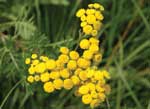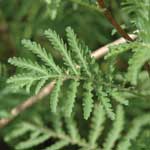Common tansy
Tanacetum vulgare L.
Keys to Identification
- Button shaped flowerheads lack petals
- Foliage is strong smelling when crushed
- Slender leaflets
This information courtesy of the Colorado Natural Areas Program.
Family
Asteraceae (Sunflower)
Other Names
Garden tansy, golden buttons
USDA Code
TAVU
Legal Status
Colorado Noxious Weed List B
Identification
Lifecycle
Perennial
Growth form
Forb/herbaceous
Flower
Yellow flowers are numerous in flat-topped dense clusters at the tops of the plants. Buttonlike flower heads lack ray flowers. July to September.
Seeds/Fruit
Seeds are yellowish brown achenes with short, five-toothed crowns.
Leaves
Leaves are alternate, deeply divided into numerous narrow, individual leaflets.
Stems
Mature plants are 11/2- 6 ft tall. Stems are often purplish-red and extensively branched towards the top.
Roots
Rhizomatous.
Other
Foliage emits a strong odor when crushed.
Impacts
Agricultural
Common tansy is considered undesirable forage for livestock. The plant is considered toxic; fortunately animals rarely ingest it as it is very unpalatable. Common tansy can impact forage quality and quantity.
Ecological
With adequate moisture common tansy will displace native and other desirable species.
Ecological
Can be toxic if large quantities are consumed.
Habitat and Distribution
General requirements
Common tansy is commonly found along roadsides, stream and irrigation ditch banks, in waste places, ornamental beds and in pastures. It grows best in full sun and on fertile, well-drained soil.
Distribution
Found throughout the United States.
Historical
Common tansy is a native of Europe that was introduced into North America as an ornamental and medicinal herb (Whitson et al. 1996). It has been used over the centuries for treating various ailments and as an insect repellent.
Biology/Ecology
Life cycle
Perennial.
Mode of reproduction
Reproduces by both seed and creeping rootstocks.
Seed production
Listed as “prolific.”
Seed bank
Viability period unknown.
Dispersal
Spread by seed movement, roots in infested topsoil and occasionally is found for sale (in violation with Colorado statute).
References
Colorado Natural Areas Program. 2000. Creating an Integrated Weed Management Plan: A Handbook for Owners and Managers of Lands with Natural Values. Colorado Natural Areas Program, Colorado State Parks, Colorado Department of Natural Resources; and Division of Plant Industry, Colorado Department of Agriculture. Denver, Colorado. 349 pages.
Dow AgroSciences. 1998. Common tansy-biennials/perennials. Dow AgroSciences. The Ranch, Pasture Improvement. Available: http://www.dowagro.com/theranch/weedres.htm
LeCain, R. & Sheley, R., Montana State University Extension Service (12/2002). Common tansy (Tanacetum vulgare). (Publication No. MT199911 AG) Retrieved October 18, 2005 from http://www.montana.edu/wwwpb/pubs/mt9911.pdf
Whitson, T.D.(ed.), L.C. Burrill, S.A. Dewey, D.W. Cudney, B.E. Nelson, R.D. Lee, R. Parker. 1996. Common tansy. Weeds of the West. Western Society of Weed Science, in cooperation with the Western United States Land Grant Universities Cooperative Extension Services, Newark CA. pg. 184


